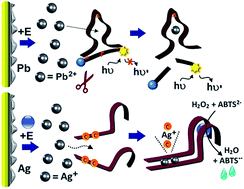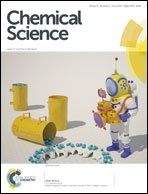Addressing, amplifying and switching DNAzyme functions by electrochemically-triggered release of metal ions
Abstract
The design of artificial cells, which mimic the functions of native cells, is an ongoing scientific goal. The development of stimuli-responsive chemical systems that stimulate cascaded catalytic transformations, trigger chemical networks, and control vectorial branched transformations and dose-controlled processes, are the minimum requirements for mimicking cell functions. We have studied the electrochemical programmed release of ions from electrodes, which trigger selective DNAzyme-driven chemical reactions, cascaded reactions that self-assemble catalytic DNAzyme polymers, and the ON–OFF switching and dose-controlled operation of catalytic reactions. The addressable and potential-controlled release of Pb2+ or Ag+ ions into an electrolyte that includes a mixture of nucleic acids, results in the metal ion-guided selection of nucleic acids yielding the formation of specific DNAzymes, which stimulate orthogonal reactions or activate DNAzyme cascades.


 Please wait while we load your content...
Please wait while we load your content...